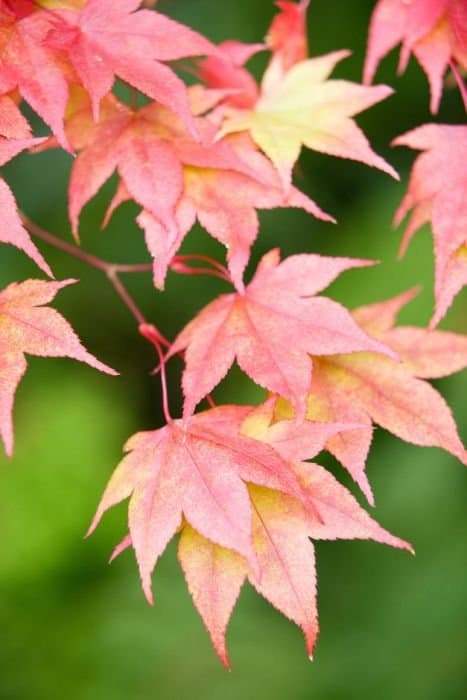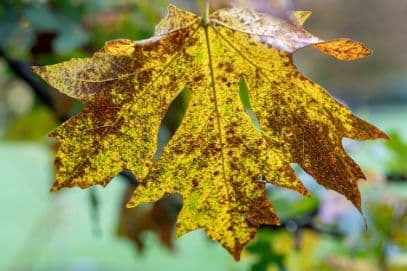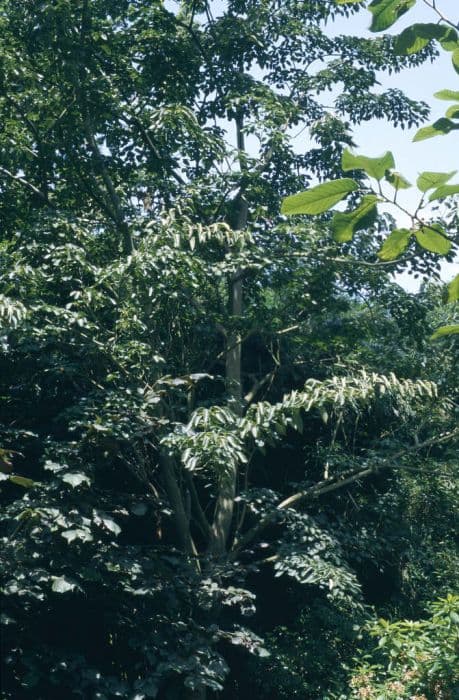Japanese Maple Acer palmatum 'Sherwood Flame' (M)

ABOUT
Acer palmatum 'Sherwood Flame', commonly known as the Japanese maple 'Sherwood Flame', is a captivating ornamental plant characterized by its striking foliage and graceful growth habit. The leaves are the main attraction, boasting a palmate shape with five to seven pointed lobes, resembling a hand with outstretched fingers. During the spring and early summer, these leaves are a vibrant green, creating a lush and refreshing canvas. As the seasons transition, the foliage undergoes a dramatic change, turning to a fiery red which gives the plant its 'Flame' namesake. This rich, crimson hue intensifies as the cooler weather sets in, making the Japanese maple 'Sherwood Flame' a showstopper in any autumn landscape. The leaves join to the branches with slender stems, slightly contrasting against the main leaf color, adding to the ornamental appeal. The plant typically exhibits a symmetrical canopy with a rounded to dome-like shape, contributing to its elegant silhouette. Subtle flowers may appear in spring, but they are often overshadowed by the magnificence of the leaves. The bark of the Japanese maple 'Sherwood Flame' adds another layer of interest with a smooth texture and color that may vary from light grey to a more muted brown, offering a gentle backdrop to the vibrant foliage display. This variety of Japanese maple is prized for its aesthetic qualities and is a favorite among gardeners and landscapers for adding a splash of color and sophistication to garden designs.
About this plant
 Names
NamesFamily
Sapindaceae
Synonyms
Japanese Maple, Red Japanese Maple, Sherwood Flame Japanese Maple
Common names
Acer palmatum 'Sherwood Flame'
 Toxicity
ToxicityTo humans
The Japanese Maple (Acer palmatum 'Sherwood Flame') is generally not considered toxic to humans. There are no well-documented cases of poisoning or significant adverse reactions from ingesting or handling parts of this plant. Consequently, consuming the plant should not cause symptoms of poisoning in humans under normal circumstances.
To pets
The Japanese Maple is also not known to be toxic to pets. It is not listed among plants that commonly cause poisoning in animals such as dogs and cats. Therefore, ingestion of this plant's parts is not expected to lead to symptoms of toxicity or serious health consequences in pets.
 Characteristics
CharacteristicsLife cycle
Perennials
Foliage type
Deciduous
Color of leaves
Red
Height
15-25 feet (4.5-7.6 meters)
Spread
10-20 feet (3-6 meters)
Plant type
Tree
Hardiness zones
5-8
Native area
Japan
Benefits
 General Benefits
General Benefits- Aesthetic Appeal: Acer palmatum 'Sherwood Flame', commonly known as Japanese Maple, boasts striking crimson-red foliage in the fall, delivering a vibrant splash of color to any garden landscape.
- Year-Round Interest: This cultivar provides visual interest throughout the year with changing leaf colors, from bright green in spring to red in summer, and fiery red in autumn.
- Shade Provision: The Japanese Maple offers a cooling canopy of shade with its elegant, layered branches and leaves, ideal for creating a serene garden nook.
- Wildlife Habitat: The tree’s structure and foliage provide shelter and nesting opportunities for various bird species, enhancing biodiversity in a garden setting.
- Compact Size: As a smaller-sized tree, Acer palmatum 'Sherwood Flame' is well-suited for gardens with limited space, allowing for ornamental use without dominating the area.
- Low Maintenance: Japanese Maples generally require minimal pruning and care once established, making them a convenient choice for both novice and expert gardeners.
- Soil Adaptability: They can tolerate a wide range of soil conditions, although they prefer well-drained, slightly acidic soil, making them versatile in different garden settings.
- Seasonal Crafts: The distinctive leaves of the Japanese Maple can be used in various crafts and decorations, especially in autumn when their color is most intense.
- Cultural Significance: The Japanese Maple is often associated with peace and tranquility, making it a valued addition to gardens designed with a contemplative or Zen aesthetic.
 Medical Properties
Medical PropertiesThis plant is not used for medical purposes.
 Air-purifying Qualities
Air-purifying QualitiesThis plant is not specifically known for air purifying qualities.
 Other Uses
Other Uses- The deep red foliage of Japanese Maple can be used in floral arrangements to provide contrast and a touch of elegance.
- Japanese Maple branches can be shaped into bonsai for an indoor display of miniature landscapes.
- Bark and leaves can be used in natural dye processes to create unique and subtle colors on fabric or yarn.
- Fallen leaves of the Japanese Maple can serve as a colorful, decorative mulch in garden beds.
- The tree's structure and fall color can be used in photography as a striking backdrop for portraits or landscape photos.
- Wood from Japanese Maple, which is hard and can have interesting grains, is occasionally used in small woodworking projects like turned bowls or ornamental objects.
- The tree can be planted as a living memorial or dedication, symbolizing beauty and grace.
- In landscape design, the Japanese Maple can be incorporated into a zen or meditation garden to foster a tranquil environment.
- Young leaves can be pressed and preserved in books or frames to create natural artwork.
- The Japanese Maple serves as an educational tool for students and hobbyists to learn about plant growth, seasonal cycles, and horticulture practices.
Interesting Facts
 Feng Shui
Feng ShuiThe Japanese Maple is not used in Feng Shui practice.
 Zodiac Sign Compitability
Zodiac Sign CompitabilityThe Japanese Maple is not used in astrology practice.
 Plant Symbolism
Plant Symbolism- Peace: The calm, serene nature of the Japanese Maple, which is the common name for Acer palmatum 'Sherwood Flame', often represents peace.
- Tranquility: The graceful form and movement of the tree's leaves in the breeze lend a tranquil feeling to the garden.
- Balance: The balanced, symmetrical growth habit of the Japanese Maple symbolizes harmony and equilibrium in life.
- Grace: With its delicate leaves and fine branches, the Japanese Maple is commonly associated with elegance and gracefulness.
- Endurance: Despite its delicate appearance, the Japanese Maple is quite hardy, signifying persistence and longevity.
- Beauty in Changing Seasons: The transformative color of the 'Sherwood Flame' throughout the seasons represents the beauty and perpetual change in life.
- Great Blessings: In some cultures, the Japanese Maple is considered a bearer of blessings, likely due to its beauty and grace.
 Water
WaterJapanese Maple trees like the 'Sherwood Flame' should be watered deeply enough to moisten the soil to a depth of at least a few inches. The tree requires consistent moisture, especially during hot and dry periods. On average, water the tree once a week with about 10 gallons during the growing season, adjusting for rainfall, soil type, and weather conditions. Reduce the frequency of watering as the tree establishes itself, usually after a couple of years, and always check the soil moisture level to avoid overwatering.
 Light
LightJapanese Maples, including 'Sherwood Flame', prefer a spot that offers partial shade to protect their leaves from harsh sunlight, especially in the afternoon. They can tolerate full sun in cooler climates but will thrive with morning sun and afternoon shade. A location that receives dappled sunlight throughout the day is ideal.
 Temperature
TemperatureThe 'Sherwood Flame' Japanese Maple can withstand a range of temperatures, with an optimal growth temperature between 60°F and 80°F. It can survive minimum temperatures down to -10°F once fully established. During the winter, protection from extreme cold below 0°F is beneficial to prevent dieback.
 Pruning
PruningPrune the 'Sherwood Flame' Japanese Maple to maintain its shape and remove any dead or diseased wood. The best time to prune is during the late winter or early spring before new growth starts. Light thinning of the canopy to allow air and light penetration is beneficial and should be done sparingly, as the tree does not respond well to heavy pruning. Prune once annually or as needed.
 Cleaning
CleaningAs needed
 Soil
SoilJapanese Maple 'Sherwood Flame' prefers well-draining soil with a pH between 5.5 and 6.5. A mix of loamy garden soil, peat moss, and perlite or pine bark can provide the ideal structure and acidity. This recipe ensures proper drainage and aeration, important for the plant's root health.
 Repotting
RepottingJapanese Maple 'Sherwood Flame' should generally be repotted every two to three years to prevent it from becoming root-bound. Younger trees may need repotting more frequently, while mature trees can go longer. Always repot in the spring just before new growth starts.
 Humidity & Misting
Humidity & MistingJapanese Maple 'Sherwood Flame' thrives best in moderate humidity levels. It can tolerate some variation but does best with humidity levels between 40% to 60%. Avoid placing it in excessively dry or highly humid environments to maintain optimal health.
 Suitable locations
Suitable locationsIndoor
Place in bright indirect light, away from drafts, water when topsoil feels dry.
Outdoor
Plant in partial shade, protected from strong winds and afternoon sun.
Hardiness zone
5-8 USDA
 Life cycle
Life cycleAcer palmatum 'Sherwood Flame', commonly known as Japanese Maple 'Sherwood Flame', begins its life cycle as a seed that germinates in favorable conditions of moisture and temperature. The seedling emerges and develops into a young plant with a set of true leaves, indicating the juvenile phase. As it matures, the plant enters a vegetative stage, characterized by the growth of distinctive palmate, red-purple leaves and a branching habit that forms its refined shape. During the reproductive phase, which occurs in spring, the tree produces small, inconspicuous red-purple flowers, followed by the development of winged samaras that disperse with the wind for propagation. Over the years, the Japanese Maple 'Sherwood Flame' experiences seasonal changes, with leaves turning a vivid red in autumn before shedding, preparing for dormancy during the winter. This cycle repeats annually as the tree gradually ages, maintaining its structural and foliar beauty for many seasons, often living several decades if cultivated under the right conditions.
 Propogation
PropogationPropogation time
Early Spring
The Japanese Maple 'Sherwood Flame' can be propagated most effectively through softwood cuttings. This technique usually takes place in late spring or early summer when the new growth is still tender and flexible. To propagate through this method, one would cut a piece of stem about 4 to 6 inches long, ensuring that there are at least 2 to 3 sets of leaves. The lower leaves are removed, and the cut end is often dipped into a rooting hormone to encourage root growth. The cutting is then planted in a well-draining soil mixture, and kept in a warm, humid environment until roots have developed, which usually takes a few weeks to a few months. It's important to keep the soil consistently moist but not waterlogged throughout the rooting process. The success of this method largely depends on the cutting's quality and the environmental conditions it is kept in after planting.








